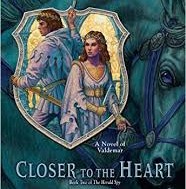Five Things I Learned Writing a Series
Today’s guest post is by Dan Rice.
When I started writing, I dreamed of creating an epic fantasy series. Hence, I set the goal to bang out a series one book after another. This posed a couple of problems.
First off, my writing was horrible, not marketable at all. My early efforts were so bad, I ultimately decided my only choice was to start over anew.
As I became more knowledgeable of the writerly world, I learned that it’s often best to market a book that works both as a stand-alone and the first in a series. I decided that was the way to go because it’s hard to gain traction while querying without saying you’ll love this book that’s the first in a fifteen-book epic fantasy series.
So that’s what I set out to do: write a book that could kick off a series and be a stand-alone. It took a long time, but eventually I produced a marketable manuscript and found a publisher. Dragons Walk Among Us kicks off The Allison Lee Chronicles, a four-book series. I’m editing the third book and have the initial outline of the fourth and final novel.
Here are a few of the lessons I’ve learned on that journey.
- The story grows
I never had empathy for authors who take years between books in a series until I wrote a series myself. The first two novels in the series each clocked in at around 87,000 words. Writing the second book was relatively easy, and I banged it out in record time. However, the third book in the series proved a harder nut to crack. The draft was nearly 130,000 words, giving me a monumental editing job.
Why did this happen? As a story grows, so does its complexity. There are more characters and fantastical beasts. Not only do the characters have the backstory of what happened to them before the first page of the first novel, they have everything they experienced in the previous books.
- Retell the backstory
You have to decide how much of the backstory to retell with each subsequent book in the series. This is tricky because it’s not always obvious what parts of the characters’ backstories must be reiterated and what can be left out. It’s easy to fall into the trap of oversharing.
One rule I follow is avoiding info dumps. I can be so zealous about following this rule that I overdo it and under-share. My critique group sometimes gets after me about this.
A helpful exercise is to research how much backstory suspense and mystery writers put into the books of their series. Often these are stand-alone books with the same protagonists for each novel. Two series that come to mind are the Lucas Davenport novels by John Sanford and the Jack Reacher books by Lee Child. In both instances, the authors give the reader just enough backstory in each book to make their protagonists multifaceted characters.
- Watch for continuity errors
We all have blind spots. In writing, this can manifest in what details you have trouble keeping straight as you jot down the words. Luckily, with a modern word processor, these can be relatively easy to track down and correct using the Find function.
Still, you must be mindful of this problem, especially when writing a series. I find myself returning to the manuscripts of earlier novels to ensure my descriptions are spot-on. Are her eyes green? Is his magical glow supposed to be blue or yellow? These are some of the easiest to spot and correct.
Even worse are problems with characterization. For example, is that minor character from book two who is now a central character in book three consistently characterized between the two novels? This kind of problem can take more work to spot and correct. The best way I know how to fix this is through careful editing.
- Spin-offs anyone?
If you have a successful series, what do you do when it ends? Move onto an entirely different project? I’m asking myself that question right now. What do I do when I write THE END on the last page of book four? Will my publisher or anyone else have any interest in my future projects?
One thing I have done while writing The Allison Lee Chronicles is leave space for a spin-off, of which I might write a separate series featuring a different character as the lead. I don’t know if I will develop the spin-off into a short story, novel, or full-fledged series, but the option is there.
- On ending
Endings have always been my bane. I have a terrible time coming up with an ending that combines the plot and the characters’ emotions. Part of my problem is that I think of a novel as part of a series instead of a stand-alone. This is probably a symptom of being a Young Adult fantasy writer.
When I found a publisher, I was told my stories needed to be self-contained, even if they were part of a series. I don’t know how well I’ve managed to do this, but they’re well enough to pass muster with my publisher, so there is that. Still, it’s something I have to work at.
I was pleasantly surprised that the ending came quite easily while working on the outline for the fourth and final book in The Allison Lee Chronicles. This leads me to believe that the ending won’t feel forced when the entire tale is finally told. Instead, the plot and emotional through lines will come together almost on their own accord, leaving the writer and, hopefully, readers satisfied.
Final Thoughts
While writing a series, expect to face challenges. Fortunately, these problems aren’t any different than those faced while writing a stand-alone novel and have the same solution—edit, edit, edit. My final advice is not to worry too much if the story grows until it feels unwieldy. That’s not a unique problem. Many authors have battled that particular dragon and carved out fantastic series.
 Dan Rice pens the Young Adult urban fantasy series The Allison Lee Chronicles in the wee hours of the morning. The series kicks off with his award-winning debut, Dragons Walk Among Us. To discover more about Dan’s writing and keep tabs on his upcoming releases, visit his website and join his newsletter.
Dan Rice pens the Young Adult urban fantasy series The Allison Lee Chronicles in the wee hours of the morning. The series kicks off with his award-winning debut, Dragons Walk Among Us. To discover more about Dan’s writing and keep tabs on his upcoming releases, visit his website and join his newsletter.
Featured Photo by Ioann-Mark Kuznietsov on Unsplash











